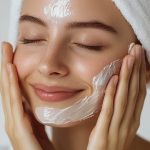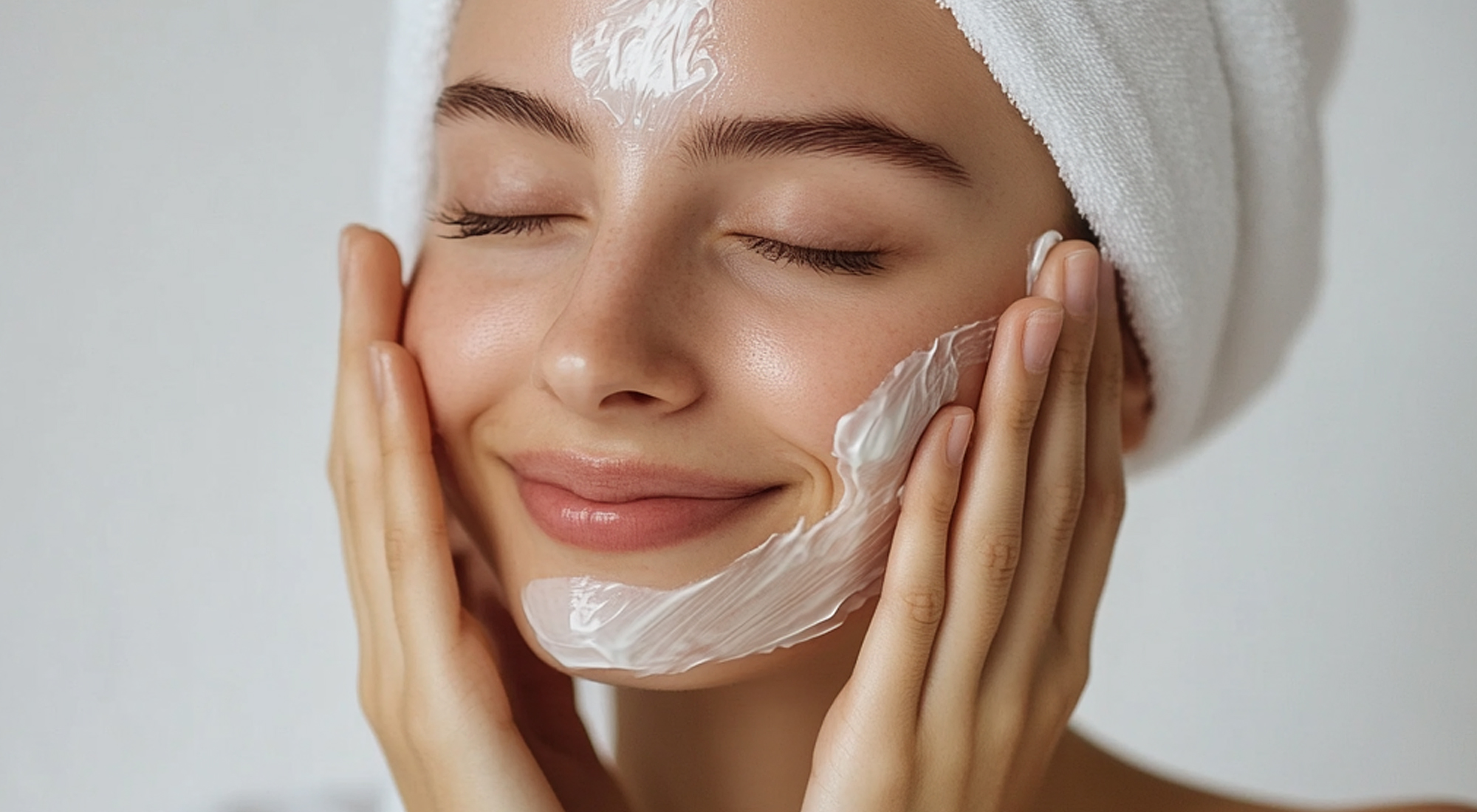Understanding your skin type is the first step in creating an effective skincare routine that caters to your unique needs. Skin type identification helps you choose the right products and treatments, ensuring optimal health and appearance for your skin.
For those with oily skin, a routine that focuses on controlling excess oil production while maintaining moisture balance is essential. Look for lightweight, non-comedogenic products that help reduce shine without clogging pores.
If you have dry skin, hydration is key. Opt for rich moisturizers and gentle cleansers that replenish lost moisture and strengthen the skin barrier to prevent flakiness and irritation.
Combination skin can be tricky to manage due to its dual nature—oily in some areas and dry in others. Combination skin tips include using different products on different parts of your face; for instance, applying a mattifying product on the T-zone while using a hydrating cream on drier areas.
Sensitive skin requires extra care with solutions focused on soothing irritation and avoiding potential triggers. Choose fragrance-free products with calming ingredients like aloe vera or chamomile to maintain comfort and reduce redness.
By understanding these specific needs through proper skin type identification, you can tailor your skincare routine effectively for healthier, more radiant skin.
The Essential Steps of an Effective Skincare Routine
An effective skincare routine is essential for maintaining healthy and radiant skin. Understanding the proper order and techniques can make all the difference in achieving optimal results. The first step in any skincare routine is a thorough cleansing routine. This involves using a gentle cleanser to remove dirt, oil, and makeup, preparing your skin for the next steps.
Following cleansing, exfoliation is crucial for removing dead skin cells and promoting cell turnover. However, it’s important to follow some key exfoliation tips: limit this step to 2-3 times a week to avoid irritation and choose an exfoliant suitable for your skin type.
After exfoliating, moisturizing techniques come into play. A good moisturizer helps lock in hydration and maintain the skin’s barrier function. Apply it while your skin is still damp to maximize absorption.
Lastly, sunscreen application should never be skipped as part of your daily skincare steps order. Sunscreen protects against harmful UV rays that can cause premature aging and damage. Opt for broad-spectrum protection with at least SPF 30 and reapply throughout the day as needed.
By following these essential steps—cleansing, exfoliating wisely, moisturizing effectively, and applying sunscreen—you can establish a comprehensive skincare routine that keeps your complexion glowing and healthy.
Selecting the Right Products for Your Skin Concerns
Choosing the right products for your skin concerns can be a transformative step in achieving a healthy and radiant complexion. It’s essential to understand what specific ingredients and formulations cater to your unique needs, whether you’re battling acne or seeking that youthful glow.
For those dealing with acne, look for acne treatment products containing salicylic acid or benzoyl peroxide, which are known for their ability to unclog pores and reduce inflammation. These ingredients can help control breakouts and promote clearer skin over time.
If anti-aging is your primary concern, consider incorporating products with anti-aging ingredients like retinol or peptides into your routine. Retinol is celebrated for its ability to accelerate cell turnover and reduce the appearance of fine lines, while peptides help boost collagen production, improving skin elasticity.
Hydration is another critical aspect of maintaining healthy skin. Hydration boosters such as hyaluronic acid are excellent at attracting moisture to the skin’s surface, ensuring it remains plump and supple. This ingredient is suitable for all skin types and can be easily layered under other treatments.
For those seeking luminous, glowing skin, investing in the best serums for glowing skin can make a significant difference. Look for serums packed with vitamin C or niacinamide—both known for their brightening properties that even out skin tone and enhance radiance.
By understanding these key ingredients and tailoring your skincare regimen accordingly, you can effectively address your specific concerns and achieve healthier-looking skin.
Morning vs. Evening Skincare Routines: What’s the Difference?
When it comes to skincare, understanding the differences between your daytime and nighttime routines is crucial for maintaining healthy, glowing skin. Each routine serves a distinct purpose and addresses different needs of your skin throughout the day.
A daytime skincare routine primarily focuses on protection. In the morning, your skin is exposed to environmental stressors such as UV rays, pollution, and dirt. Therefore, an effective AM regimen typically includes a gentle cleanser to remove overnight impurities, followed by an antioxidant-rich serum to combat free radicals. The most crucial step in any daytime skincare routine is applying a broad-spectrum sunscreen with at least SPF 30 to shield your skin from harmful UV rays.
In contrast, a nighttime skincare regimen is all about repair and rejuvenation. During sleep, your skin undergoes its natural healing process. To aid this renewal phase, start with a thorough cleanse to remove makeup and any accumulated grime from the day. Follow up with treatments like retinoids or exfoliants that promote cell turnover and target specific concerns such as fine lines or acne. A nourishing moisturizer or night cream can then be applied to lock in hydration and support the skin’s repair mechanisms while you rest.
Understanding these AM vs PM differences ensures that you’re giving your skin exactly what it needs at each time of day—protection during daylight hours and intensive care during the night—setting you on the path towards healthier-looking skin.
Avoiding Common Skincare Mistakes and Misconceptions
Navigating the world of skincare can be overwhelming, especially with the abundance of myths and misconceptions circulating. Understanding these common pitfalls is essential for maintaining healthy skin. One prevalent myth is that more exfoliation leads to better skin. In reality, over-exfoliation can strip your skin of its natural oils, leading to irritation and increased sensitivity. Look for warning signs such as redness, dryness, or a stinging sensation, which indicate it’s time to dial back.
Another common mistake involves improper product layering. Many believe that simply applying more products will enhance results; however, this can lead to clogged pores and reduced effectiveness of each product. To avoid this pitfall, layer products from thinnest to thickest consistency—starting with serums and ending with moisturizers—to ensure optimal absorption.
By debunking these skincare myths and being mindful of over-exfoliation warning signs and correct product layering techniques, you can cultivate a routine that truly benefits your skin’s health and appearance.
Tweaking and Adjusting Your Routine Over Time for Optimal Results
As we navigate the ever-evolving landscape of skincare, it’s essential to remember that our routines should be as dynamic as our lives. One significant factor in maintaining optimal skin health is recognizing the need for seasonal skincare changes. As the weather shifts, so do our skin’s requirements. For instance, during colder months, you might find your skin craving more hydration due to dry air and indoor heating. Conversely, summer may call for lighter moisturizers and increased sun protection.
Another crucial aspect is adapting to aging skin needs. As we age, our skin undergoes various changes such as decreased elasticity and moisture levels. Incorporating products rich in antioxidants and peptides can help address these concerns by promoting collagen production and protecting against environmental damage.
Tracking progress in skincare goals is also vital for achieving desired results. Keeping a journal or using apps dedicated to skincare can help monitor how your routine affects your skin over time. By observing patterns and outcomes, you can make informed decisions about what adjustments may be necessary to keep your complexion healthy and radiant.
In conclusion, tweaking and adjusting your skincare routine over time is not just beneficial—it’s essential for achieving optimal results tailored to your unique needs throughout different seasons of life.










